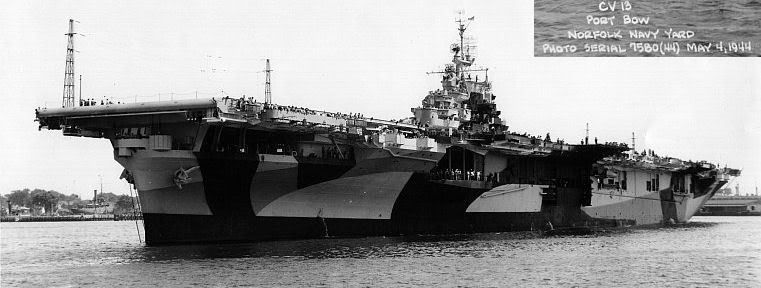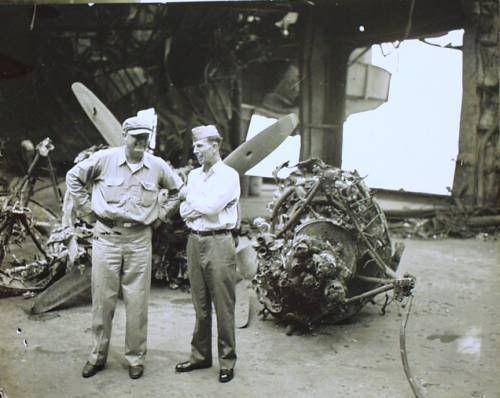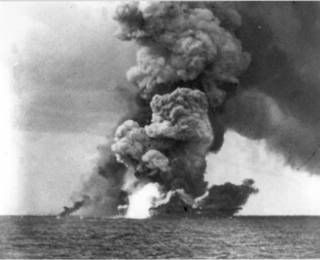Information
Learn the history of the U.S. Navy and share pictures and stories about sailors in your family history.
Website: http://www.navydads.ning.com/group/navyhistory
Members: 56
Latest Activity: Jul 26, 2017
This is a group where we can share our knowledge of the history of the U.S. Navy. Post links with historical information and archived photos. Share stories and photos that have been passed on to us by family members or friends.
Discussion Forum
To HooYah or not to HooYah
Started by Mr. Sailorette. Last reply by Ron Fordham Jun 12, 2015. 1 Reply 0 Likes
This Day in Naval History - June 14
Started by NavyDads CoAdmin Jim Gramza Jun 14, 2012. 0 Replies 1 Like
Comment Wall
Comment
-
Comment by Susan J on June 18, 2009 at 6:39pm
-
If you want some intresting stories frm the Uss franklin...check out this web page: http://www.ussfranklin.org/menu/stories.html
-
Comment by Susan J on June 18, 2009 at 6:25pm
-
Did many of you know that the main ship for that time was the ship for the famous flying squadron.. The Black Sheep Squadron. Robert E. Gentry, Sgt, USMC, (Jun 8, 1924 – Dec 26, 1967) served on the Franklin that day. He was with many of his Marine buddies, Kenneth (KK) Thompson, Mike Sansone, John Norman, Joe Titus, Patrick Sculley, all members of the infamous group, Black Sheep Squadron. Half of the squadron assigned to the Franklin perished; lost, but not forgotten.
-
Comment by NavyDads Admin (Paul) on June 18, 2009 at 5:06pm
-
Thanks for sharing with us Susan...it's rare that we have such a personal connection to such a piece of history on the site. So many of the heroic vets are now gone and with them much of the history that has shaped the US Navy. I look forward to learning more about the amazing story of the Franklin.
-
Comment by Susan J on June 18, 2009 at 4:56pm
-
Comment by Susan J on June 18, 2009 at 4:47pm
-
This is the ship my uncle served on and was on this ship when this happened, his name, Commander Donald Gary USN (deceased). For his actions on that day he and the Chaplain received the Congressional Medal of Honor.

Before dawn on 19 March 1945 the U.S.S. Franklin, who had maneuvered closer to the Japanese mainland than had any other U.S. carrier during the war, launched a fighter sweep against Honshu and later a strike against shipping in Kobe Harbor. Suddenly, a single enemy plane pierced the cloud cover and made a low level run on the gallant ship to drop two semi-armor piercing bombs. One struck the flight deck centerline, penetrating to the hangar deck, effecting destruction and igniting fires through the second and third decks, and knocking out the combat information center and airplot. The second hit aft, tearing through two decks and fanning fires, which triggered ammunition, bombs and rockets. The Franklin, within 50 miles of the Japanese mainland, lay dead in the water, took a 13° starboard list, lost all radio communications, and broiled under the heat from enveloping fires. Many of the crew were blown overboard, driven off by fire, killed or wounded, but the 106 officers and 604 enlisted who voluntarily remained saved their ship through sheer valor and tenacity. The casualties totaled 724 killed and 265 wounded, and would have far exceeded this number except for the heroic work of many survivors. Among these were Medal of Honor winners, Lieutenant Commander Joseph T. O'Callahan, S. J., USNR, the ship's chaplain, who administered the last rites, organized and directed firefighting and rescue parties, and led men below to wet down magazines that threatened to explode, and Lieutenant (junior grade) Donald Gary who discovered 300 men trapped in a blackened mess compartment, and finding an exit, returned repeatedly to lead groups to safety. The U.S.S. Santa Fe (CL-60) similarly rendered vital assistance in rescuing crewmen from the sea and closing the Franklin to take off the numerous wounded.
The Franklin was taken in tow by the U.S.S. Pittsburgh until she managed to churn up speed to 14 knots and proceed to Pearl Harbor where a cleanup job permitted her to sail under her own power to Brooklyn, N.Y., arriving on 28 April. Following the end of the war, the Franklin was opened to the public, for Navy Day celebrations, and on 17 February 1947 was placed out of commission at Bayonne, N.J. On 15 May 1959 she was reclassified AVT 8.
The U.S.S. Franklin received four battle stars for World War II service.
-
Comment by Kathleen~Ma of Jonis on June 15, 2009 at 8:59pm
-
Hi Ya'll.... I really look forward to learning more about Navy History...
-
Comment by Tony on June 12, 2009 at 2:57pm
-
Those pictures are simply amazing. Thanks Paul. Great photos.
-
Comment by Paige on June 12, 2009 at 2:45pm
-
Paul, thanks for sharing. I've seen alot of photos taken on the day of the attack, but I haven't seen any with the quality and clarity of these photos. They are "spectacular"!! I'm curious to know more about the foot locker and where it was for so long before its contents were gone through. Maybe we will be able to learn more about that part of the story one day.
-
Comment by NavyDads Admin (Paul) on June 12, 2009 at 1:46pm
-
I recently received an intersting e-mail for a friend that I thought I would post:
PHOTOS STORED IN AN OLD BROWNIE CAMERA
Thought you might find these photos very interesting; what quality from 1941.
Pearl Harbor photos found in an old Brownie stored in a foot locker. and just recently
taken to be developed.
THESE PHOTOS ARE FROM A SAILOR WHO WAS ON THE USS QUAPAW ATF-11O.
I THINK THEY'RE SPECTACULAR!
PEARL HARBOR
December 7th, 1941
Pearl Harbor
On Sunday, December 7th, 1941 the Japanese launched a surprise attack against the U.S. Forces stationed at Pearl Harbor , Hawaii By planning his attack on a Sunday, the Japanese commander Admiral Nagumo, hoped to catch the entire fleet in port... As luck would have it, the Aircraft Carriers and one of the Battleships were not in port. (The USS Enterprise was returning from Wake Island , where it had just delivered some aircraft. The USS Lexington was ferrying aircraft to Midway, and the USS Saratoga and USS Colorado were undergoing repairs in the United States .)
In spite of the latest intelligence reports about the missing aircraft carriers (his most important targets), Admiral Nagumo decided to continue the attack with his force of six carriers and 423 aircraft. At a range of 230 miles north of Oahu , he launched the first wave of a two-wave attack. Beginning at 0600 hours his first wave consisted of 183 fighters and torpedo bombers which struck at the fleet in Pearl Harbor and the airfields in Hickam, Kaneohe and Ewa. The second strike, launched at 0715 hours, consisted of 167 aircraft, which again struck at the same targets.
At 075 3 hours the first wave consisting of 40 Nakajima B5N2 'Kate' torpedo bombers, 51 Aichi D3A1 'Val' dive bombers, 50 high altitude bombers and 43 Zeros struck airfields and Pearl Harbor Within the next hour, the second wave arrived and continued the attack.
When it was over, the U.S. Losses were:
Casualties
US Army: 218 KIA, 364 WIA.
US Navy: 2,008 KIA, 710 WIA.
US MarineCorp: 109 KIA, 69 WIA.
Civilians: 68 KIA, 35 WIA.
TOTAL: 2,403 KIA, 1,178 WIA.
-------------------------------------------------
Battleships
USS Arizona (BB-39) - total loss when a bomb hit her magazine.
USS Oklahoma (BB-37) - Total loss when she capsized and sank in the harbor.
USS California (BB-4 4) - Sunk at her berth. Later raised and repaired.
USS West Virginia (BB-48) - Sunk at her berth. Later raised and repaired.
USS Nevada - (BB-36) Beached to prevent sinking. Later repaired.
USS Pennsylvania (BB-38) - Light damage.
USS Maryland (BB-46) - Light damage.
USS Tennessee (BB-43) Light damage.
USS Utah (AG-16) - (former battleship used as a target) - Sunk.
--------------------------------------------------------------------------------------------------------------------------
Cruisers
USS New Orleans (CA-32) - Light Damage..
USS San Francisco (CA-38) - Light Damage.
USS Detroit (CL-8) - Light Damage.
USS Raleigh (CL-7) - Heavily damaged but repaired.
USS Helena (CL-50) - Light Damage.
USS Honolulu (CL-48) - Light Damage..
-------------------------- -- ---------------------------- ---------------------------------------------------------------
Destroyers
USS Downes (DD-375) - Destroyed. Parts salvaged.
USS Cassin - (DD -3 7 2) Destroyed. Parts salvaged.
USS Shaw (DD-373) - Very heavy damage.
USS Helm (DD-388) - Light Damage.
----------------------------------------------------------------------------------------------------------------------
Minelayer
USS Ogala (CM-4) - Sunk but later raised and repaired.
----------------------------------------------------------------------------------
Seaplane Tender
USS Curtiss (AV-4) - Severely damaged but later repaired.
------------------------------------------------------------------------------------
Repair Ship
USS Vestal (AR-4) - Severely damaged but later repaired.
------------------------------------------------------------------------------------
Harbor Tug
USS Sotoyomo (YT-9) - Sunk but later raised and repaired.
--------------------------------------------------------------------------------------------
Aircraft
188 Aircraft destroyed (92 USN and 92 U.S. Army Air Corps.)
-
Comment by Paige on June 6, 2009 at 1:34pm
-
D-Day Introduction
June 1944 was a major turning point of World War II, particularly in Europe. Although the initiative had been seized from the Germans some months before, so far the western Allies had been unable to mass sufficient men and material to risk an attack in northern Europe.
By mid-1944 early mobilization of manpower and resources in America was beginning to pay off. Millions of American men had been trained, equipped, and welded into fighting and service units. American industrial production had reached its wartime peak late in 1943. While there were still critical shortages -- in landing craft, for instance -- production problems were largely solved, and the Battle of the Atlantic had been won. Ever increasing streams of supplies from the United States were reaching anti-Axis fighting forces throughout the world.
By the beginning of June 1944, the United States and Great Britain had accumulated in the British Isles the largest number of men and the greatest amount of materiel ever assembled to launch and sustain an amphibious attack. Strategic bombing of Germany was reaching its peak. In May 1943, the Combined Chiefs of Staff had given high priority to a Combined Bomber Offensive to be waged by the Royal Air Force and the U.S. Army Air Forces. By late summer 1943, Allied bombers were conducting round-the-clock bombardment of German industry and communications. In general, British planes bombed by night and American planes bombed by day. Whereas an air raid by 200 planes had been considered large in June 1943, the average strike a year later was undertaken by 1,000 heavy bombers.
After considerable study strategists determined to make the cross-channel attack on the beaches of Normandy east of the Cherbourg Peninsula. Early objectives of the operation were the deep-water ports at Cherbourg and at Brest in Brittany.
Three months before D-Day, a strategic air campaign was inaugurated to pave the way for invasion by restricting the enemy's ability to shift reserves. French and Belgian railways were crippled, bridges demolished in northwestern France, and enemy airfields within a 130-mile radius of the landing beaches put under heavy attack. Special attention was given to isolating the part of northwestern France bounded roughly by the Seine and Loire Rivers. The Allies also put into effect a deception plan to lead the Germans to believe that landings would take place farther north along the Pas de Calais.
Opposed to the Allies was the so-called Army Group B of the German Army, consisting of the Seventh Army in Normandy and Brittany, the Fifteenth Army in the Pas de Calais and Flanders, and the LXXXVIII Corps in Holland -- all under command of Field Marshal Erwin Rommel. Commander of all German forces in western Europe was Field Marshal von Rundstedt who, in addition to Group B, also had at his disposal Group G composed of the First and Nineteenth Armies. In all, Von Rundstedt commanded approximately fifty infantry and ten Panzer divisions in France and the Low Countries.
Despite unfavorable weather forecasts, General Eisenhower made the decision to attack on June 6, 1944. At 0200 that morning one British and two American airborne divisions were dropped behind the beaches in order to secure routes of egress from the beaches for the seaborne forces. After an intensive air and naval bombardment, assault waves of troops began landing at 0630. More than 5,000 ships and 4,000 ship-to-shore craft were employed in the landings. British forces on the left flank and U.S. forces on the right had comparatively easy going, but U.S. forces in the center (Omaha Beach) met determined opposition. Nevertheless, by nightfall of the first day, large contingents of three British, one Canadian, and three American infantry divisions, plus three airborne divisions, had a firm foothold on Hitler's "fortress Europe."
[Note: The primary source for this text is the U.S. Army Center for Military History.]
© 2024 Created by E.G. - ND's Creator/Admin.
Powered by
![]()



You need to be a member of Navy History to add comments!